Korean Syllable Blocks
The Korean text pronunciation feature (🔊) is only available for Chrome, Edge, Safari, and Opera browsers.
Syllable blocks
As you may have noticed from previous examples, in Korean, vowels are sometimes written immediately after a consonant, and at other times, they are written below it.
The position of a vowel in a syllable depends on its type.
Vertical vowels are always written next to a consonant (to the right). Horizontal vowels are always written below a consonant.
Vertical and Horizontal Korean vowels
Vertical Vowels: ㅏ, ㅑ, ㅓ, ㅕ, ㅣ, ㅐ, ㅒ, ㅔ, ㅖ
Horizontal Vowels: ㅗ, ㅛ, ㅜ, ㅠ, ㅡ
Combined Vowels: ㅘ, ㅙ, ㅚ, ㅝ, ㅞ, ㅟ, ㅢ

Tips: One way to easily remember which category a Korean vowel belongs to is to identify which stroke is the longest. If a vertical stroke is the longest, then the vowel is vertical. If the longest stroke is horizontal, then the vowel is horizontal. And if a vowel is composed of both horizontal and vertical vowels, then the vowel is combined.
So, based on these characteristics of Korean vowels, we can distinguish eight types of syllable blocks.
2 letters based:

3 letters based:

4 letters based:

The final consonant(s) in a syllable is called "batchim".


Exercises
Quick reference (click to open)
Vowels: a, e, i, o, u
Consonants: b, c, d, f, g, h, j
Syllable: Bra-zil (2 syllables), Ar-gen-ti-na (4), In-di-a (3), Viet-nam (2), thin-king (2), beau-ti-ful (3), good (1)
Batchim: is a final consonant in a syllable. → Bra-zil (batchim: 'l'), Ar-gen-ti-na (batchims: 'r' and 'n'), In-di-a ('n'), Viet-nam ('t', 'm')
Romanization: is a conversion of text (not pronunciation ! ) from different writing system (Korean, Arabic, Russian, etc.) to the Roman (Latin) alphabet.
IPA: is an alphabetic system of phonetic (pronunciation) notation.
Noun: road, user, sister, table, sky
Pronoun: I, my, we, you, they, her
Verb: to go, to study, to think, to feel
Adjective: cold, kind, hungry, curious, expensive
Adverb: quickly, nicely, never, exactly, urgently
Preposition: from, to, on, in, with, till
Conjuction: and, because, if, but, while
Declarative sentence: I learn Korean.
Interrogative sentence: Do you learn Korean?
Imperative sentence: You must learn Korean!
Exclamative sentence: Wow, you learn Korean!
Verb / Adj. stem in Korean: part of a verb or adj. which is left after removing the last syllable -다 ( e.g. 가다 → 가, 예쁘다 → 예쁘, 듣다 → 듣 ).



